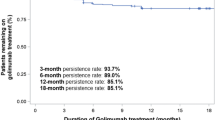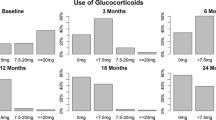Abstract
Glucocorticoids (GC) are widely used to treat systemic sclerosis (SSc). The lack of efficacy data and patient/physician concerns may prompt therapy discontinuation. The aim of this study is to identify factors hampering GC discontinuation in patients with stable disease on oral GC for longer than 12 months. Consecutive patients fulfilling the 2013 ACR/EULAR criteria for SSc and with stable disease were prescribed a slow tapering GC regimen to achieve discontinuation. At study entry and 6 months later (T6), patients were assessed for disease activity and severity. Moreover, the Short-Form-36; the Health Assessment Questionnaire Disability Index (HAQ-DI); and visual analog scales for fatigue, pain, and general health were completed. Reasons for stopping the discontinuation regimen were recorded. Forty-eight patients (46 females, 9 diffuse SSc), with a mean ± SD age of 56±14 years and a median disease duration of 10 years (range 2–22), were enrolled. The median daily GC dose was 5 mg (range 5–10; all patients treated with prednisone). At T6, 33 (68.7 %) patients had discontinued GC. The remaining 15 patients could not discontinue GC because of arthralgia in eight, arthritis in two, puffy fingers in two, increased creatine-kinase in two, and bursitis in one patient. At multiple logistic analysis, a higher baseline HAQ-DI was the only independent factor associated with GC need (OR 2.98, 95 % CI 1.20–7.41; p = 0.01). About one third of SSc patients did not achieve a GC-free regimen. Disability as assessed by HAQ-DI was the leading factor hindering GC discontinuation. A low HAQ-DI score can identify candidates for GC discontinuation.

Similar content being viewed by others
References
Gabrielli A, Avvedimento EV, Krieg T (2009) Scleroderma. N Engl J Med 60:1989–2003
Walsh LJ, Wong CA, Pringle M, Tattersfield AE (1996) Use of oral corticosteroids in the community and the prevention of secondary osteoporosis: a cross sectional study. BMJ 10:344–6
Jacobs JW, Bijlsma JW (2011) Glucocorticoids in rheumatology: indications and routes of administration. Clin Exp Rheumatol 29(5 Suppl 68):S81–4
Posnik J (1963) Systemic lupus erythematosus. The effect of corticotropin and adrenocorticoid therapy on survival rate. Calif Med 98:308–12
Albert DA, Hadler NM, Ropes MW (1979) Does corticosteroid therapy affect the survival of patients with systemic lupus erythematosus? Arthritis Rheum 22:945–53
Iudici M, Fasano S, Iacono D et al (2014) Prevalence and factors associated with glucocorticoids (GC) use in systemic sclerosis (SSc): a systematic review and meta-analysis of cohort studies and registries. Clin Rheumatol 33:153–64
Hunzelmann N, Moinzadeh P, Genth E et al (2009) High frequency of corticosteroid and immunosuppressive therapy in patients with systemic sclerosis despite limited evidence for efficacy. Arthritis Res Ther 11:R30
Iudici M, van der Goes MC, Valentini G, Bijlsma JW (2013) Glucocorticoids in systemic sclerosis: weighing the benefits and risks—a systematic review. Clin Exp Rheumatol 31(2 Suppl 76):157–65
Postolova A, Chen JK, Chung L (2016) Corticosteroids in myositis and scleroderma. Rheum Dis Clin North Am 42:103–18
Steen VD (2003) Scleroderma renal crisis. Rheum Dis Clin North Am 29:315–33
Iudici M, Russo B, Mitidieri M, Cuomo G, Valentini G (2015) Glucocorticoids in systemic sclerosis: patients’ beliefs and treatment adherence. Scand J Rheumatol 44:229–37
Arena C, Morin AS, Blanchon T et al (2010) Impact of glucocorticoid-induced adverse events on adherence in patients receiving long-term systemic glucocorticoid therapy. Br J Dermatol 163:832–7
Fardet L, Flahault A, Kettaneh A et al (2007) Corticosteroid-induced clinical adverse events: frequency, risk factors and patient’s opinion. Br J Dermatol 157:142–8
van der Goes MC, Jacobs JWJ, Boers M et al (2010) Monitoring adverse events of low-dose glucocorticoid therapy: EULAR recommendations for clinical trials and daily practice. Ann Rheum Dis 69:1913–19
Mosca M, Tani C, Aringer M (2013) Withdrawal of therapy in non-renal systemic lupus erythematosus: is this an achievable goal? Clin Exp Rheumatol 31:S71–4
Luqmani RA (2013) Discontinuation of therapies in vasculitis. Clin Exp Rheumatol 31:S93–7
Urowitz MB, Feletar M, Bruce IN, Ibañez D, Gladman DD (2005) Prolonged remission in systemic lupus erythematosus. J Rheumatol 32:1467–72
van den Hoogen F, Khanna D, Fransen J et al (2013) 2013 classification criteria for systemic sclerosis: an American College of Rheumatology/European League Against Rheumatism Collaborative Initiative. Ann Rheum Dis 72:1747–55
Medsger TA Jr, Bombardieri S, Czirjak L, Scorza R, Della Rossa A, Bencivelli W (2003) Assessment of disease severity and prognosis. Clin Exp Rheumatol 21:S42–6
Valentini G, Cuomo G, Abignano G et al (2011) Early systemic sclerosis: assessment of clinical and pre-clinical organ involvement in patients with different disease features. Rheumatology (Oxford) 50:317–2
Valentini G, Della Rossa A, Bombardieri S et al (2001) European multicentre study to define disease activity criteria for systemic sclerosis. II. Identification of disease activity variables and development of preliminary activity indexes. Ann Rheum Dis 60:592–8
Walker UA, Tyndall A, Czirjak L et al (2007) Clinical risk assessment of organ manifestations in systemic sclerosis: a report from the EULAR Scleroderma Trials and Research Group database. Ann Rheum Dis 66:754–63
LeRoy EC, Black C, Fleischmajer R et al (1988) Scleroderma (systemic sclerosis): classification, subsets and pathogenesis. J Rheumatol 15:202–5
Valentini G, Marcoccia A, Cuomo G et al (2013) Early systemic sclerosis: marker antibodies and video capillaroscopic findings are each associated with distinct clinical, functional and cellular activation markers. Arthritis Res Ther 15:R63
Apolone G, Mosconi P (1998) The Italian SF-36 Health Survey: translation, validation and norming. J Clin Epidemiol 51:1025–36
La Montagna G, Cuomo G, Chiarolanza I, Ruocco L, Valentini G (2006) [HAQ-DI Italian version in systemic sclerosis]. Reumatismo 58:112–5
Broersen LH, Pereira AM, Jørgensen JO, Dekkers OM (2015) Adrenal insufficiency in corticosteroids use: systematic review and meta-analysis. J Clin Endocrinol Metab 100:2171–80
Alves C, Robazzi T, Mendonca M (2008) Withdrawal from glucocorticosteroid therapy: clinical practice recommendations. J Pediatr (Rio J) 84:192–202
Amatruda TT, Hollingsworth D, D’Esopo ND et al (1960) A study of the mechanism of the steroid withdrawal syndrome. Evidence for integrity of the hypothalamic-pituitary-adrenal system. J Clin Endocrinol Metab 20:339–54
Corzillius M, Bae S (1999) Methodological issues of corticosteroid use in SLE trials. Lupus 8:692–7
Ad Hoc Working Group on Steroid-Sparing Criteria in Lupus (2004) Criteria for steroid-sparing ability of interventions in systemic lupus erythematosus. Arthritis Rheum 11:3427–3431
AbouZaha A, Fang H, Madger LS, Petri M (2013) Predictors of corticosteroid tapering in SLE patients: the Hopkins Lupus Cohort. Lupus 22:697–701
Tseng CE, Buyon J, Kim M et al (2006) The effect of moderate-dose corticosteroids in preventing severe flares in patients with serologically active, but clinically stable, systemic lupus erythematosus. Arthritis Rheumatol 54:3623–32
Luqmani R (2013) Discontinuation of therapies in vasculitis. Clin Exp Rheumatol 31(Suppl. 78):S93-S97
Spiera RF, Mitnick HJ, Kupersmith M et al (2001) A prospective, double-blind, randomized, placebo controlled trial of methotrexate in the treatment of giant cell arteritis (GCA). Clin Exp Rheumatol 19:495–501
Visvanathan S, Rahman MU, Hoffman GS et al (2011) Tissue and serum markers of inflammation during the follow-up of patients with giant-cell arteritis—a prospective longitudinal study. Rheumatology (Oxford) 50:2061–70
Jover JA, Hernandez-Garcia C, Morado IC, Vargas E, Baňares A, Fernandez-Gutierrez B (2001) Combined treatment of giant-cell arteritis with methotrexate and prednisone. A randomized, double-blind, placebo-controlled trial. Ann Intern Med 134:106–14
Caporali R, Scirè CA, Todoerti M, Montecucco C (2013) The role of low-dose glucocorticoids for rheumatoid arthritis in the biologic era. Clin Exp Rheumatol 31(4 Suppl 78):S9–13
Bijlsma JW (2012) Disease control with glucocorticoid therapy in rheumatoid arthritis. Rheumatology (Oxford);51 Suppl 4:iv9-13
Pincus T, Swearingen CJ, Luta G, Sokka T (2009) Efficacy of prednisone 1–4 mg/day in patients with rheumatoid arthritis: a randomised, double-blind, placebo controlled withdrawal clinical trial. Ann Rheum Dis 68:1715–20
Cuomo G, Zappia M, Abignano G, Iudici M, Rotondo A, Valentini G (2009) Ultrasonographic features of the hand and wrist in systemic sclerosis. Rheumatology 48:1414–7
Elhai M, Guerini H, Bazeli R, et al. Ultrasonographic hand features in systemic sclerosis and correlates with clinical, biologic, and radiographic findings. Arthritis Care & Research;8:1244–1249
Avouac J, Clements PJ, Khanna D, Furst DE, Allanore Y (2012) Articular involvement in systemic sclerosis. Rheumatology (Oxford) 51:1347–56
Steen VD, Medsger TA Jr (1997) The value of the Health Assessment Questionnaire and special patient-generated scales to demonstrate change in systemic sclerosis patients over time. Arthritis Rheum 40:1984–91
Clements PJ, Kee Wong W, Hurwitz EL et al (2001) The Disability Index of the Health Assessment questionnaire is a predictor and correlate of outcome in the high-dose versus low-dose penicillamine in systemic sclerosis trial. Arthritis Rheum 44:653–61
Lawrence E, Pope J, Al Zahraly Z, Lalani S, Baron M (2009) The relationship between changes in self-reported disability (measured by the Health Assessment Questionnaire-HAQ) in scleroderma and improvement of disease status in clinical practice. Clin Exp Rheumato 27(54):32–7
Dinsen S, Baslund B, Klose M et al (2013) Why glucocorticoid withdrawal may sometimes be as dangerous as the treatment itself. Eur J Intern Med 24:714–20
Kowal-Bielecka O, Landewe R, Avouac J et al (2009) EULAR recommendations for the treatment of systemic sclerosis: a report from the EULAR Scleroderma Trials and Research group (EUSTAR). Ann Rheum Dis 68:620–8
Acknowledgments
We thank Jean Ann Gilder (Scientific Communication SRL) for editing the text.
Author information
Authors and Affiliations
Corresponding author
Ethics declarations
Disclosures
None.
Rights and permissions
About this article
Cite this article
Iudici, M., Vettori, S., Russo, B. et al. Outcome of a glucocorticoid discontinuation regimen in patients with inactive systemic sclerosis. Clin Rheumatol 35, 1985–1991 (2016). https://doi.org/10.1007/s10067-016-3300-3
Received:
Revised:
Accepted:
Published:
Issue Date:
DOI: https://doi.org/10.1007/s10067-016-3300-3




